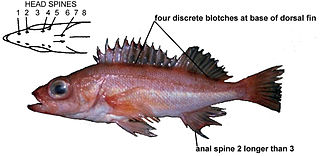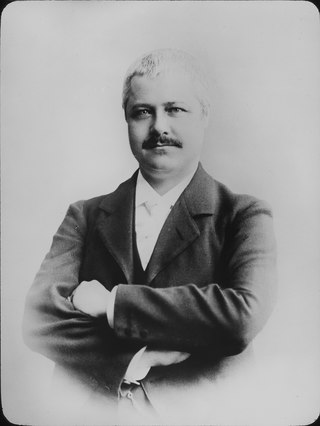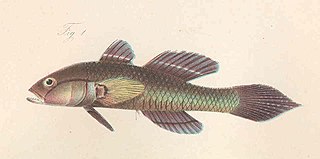Victor Gruschka Springer is Senior Scientist emeritus, Division of Fishes at the Smithsonian Institution's National Museum of Natural History in Washington, D.C. He is a specialist in the anatomy, classification, and distribution of fishes, with a special interest in tropical marine shorefishes. He has published numerous scientific studies on these subjects; also, a popular book called "Sharks in Question, the Smithsonian Answer Book" 1989.

Mugilogobius is a genus of fish in the family Gobiidae. They are found in fresh, brackish and marine water of the Indo-Pacific region. Several of the freshwater species have highly restricted distributions.
Mugilogobius sarasinorum, Sarasin's goby, is a species of goby endemic to Lake Poso in Sulawesi, Indonesia. This species can reach a length of 8 centimetres (3.1 in) TL. It is important to local commercial fisheries and the fishing community.

The pygmy rockfish, also known as the slender rockfish or Wilson's rockfish, is a species of marine ray-finned fish belonging to the subfamily Sebastinae, the rockfishes, part of the family Scorpaenidae. It is found in the eastern Pacific Ocean.

Fritz Sarasin, full name Karl Friedrich Sarasin was a Swiss naturalist.
Heteroclinus wilsoni, or Wilson's weedfish, is a species of clinid found along the coast of southern Australia and Tasmania where it can be found in weedy reefs from the intertidal zone down to a depth of about 20 metres (66 ft). This species can reach a maximum length of 14 centimetres (5.5 in) TL. The specific name honours John Bracebridge Wilson (1828-1895), a naturalist and headmaster who collected the type.
Gerald Robert "Gerry" Allen is an American-born Australian ichthyologist. His career began in 1963, when he spent a semester at the University of Hawaii, where he also received a PhD in marine zoology in 1971. In 1972, Allen wrote his doctoral thesis on the systematics and biology of the anemone fish.
Echinogobius hayashii, the cheek-streaked goby, is a species of goby native to western Australia and Japan. This species can be found at depths of from 1 to 20 metres living in areas with strong tidal currents and a sandy substrate. This species grows to a length of 7 centimetres (2.8 in) SL. This species is the only known member of its genus.
Larsonella pumila is a species of goby native to the Indian Ocean from the coast of Africa to the western Pacific Ocean. This species grows to a length of 1.9 centimetres (0.75 in) SL. This species is the only known member of its genus. The specific name honours the ichthyologist Helen K. Larson who was the Curator of Fishes at the Museum and Art Gallery of the Northern Territory in Darwin, for her work on the taxonomy of Indo-Pacific gobies.

Porogobius schlegelii is a species of goby native to brackish and fresh waters along the Atlantic coast of Africa from Senegal to the Democratic Republic of the Congo. It is also found in the islands of the Gulf of Guinea and Cape Verde. It occurs in inshore waters in lagoons, estuaries, the lower reaches of rivers and mangrove swamps. This species grows to a length of 14.9 centimetres (5.9 in) TL. This species is the only known member of its genus. The specific name honours the ichthyologist Hermann Schlegel (1804-1884) who supplied Günther with the type specimen from the Natural History Museum in Leiden.
Kurtus gulliveri, the nurseryfish, is a species of fish in the family Kurtidae native to fresh and brackish waters in southern New Guinea and northern Australia. They can be found in estuaries, mangrove swamps, nipa swamps and slow-flowing rivers with high turbidity. This species can reach a length of 63 cm (25 in), although most are far smaller: In a study of its morphology, 159 specimens were examined and the largest was 33 cm (13 in), while the average was 14 cm (5.5 in). This species is famous for its unusual breeding strategy where the male carries the egg cluster on a hook protruding from the forehead (supraoccipital). Females do not have a hook. It feeds on crustaceans, small fish and insect larvae. This species is well regarded as food. The specific name honours a "Mr Gulliver" who collected the type, thought most likely to refer to Thomas Allen Gulliver (1847-1931) who worked on Australia's a post and telegraph services and who lived near the Norman River, Gulf of Carpentaria where he collected natural history specimens and where the type of this species was collected.

Hemigobius hoevenii, commonly known as the banded mulletgoby, is a species of goby which occurs in the western Indo-Pacific region from Thailand to New Guinea and northern Australia where it is found in mangroves. The specific name most likely honours the Dutch ichthyologist Jan van der Hoeven (1801-1868) who has been honoured by Pieter Bleeker in a number of names for taxa.
Mugilogobius chulae, commonly known as the yellowstripe goby or Chulae's goby, is a species of freshwater, brackish goby, where it feeds on small crustaceans, aquatic insects and insect larvae. It is found in coastal eastern Asia from the Ryukyu Islands south to Sumatra.
Pandaka lidwilli, or the Lidwill's dwarf goby, is a species of goby found in brackish and salt water in the mouths of rivers and maritime zones in Japan, Australia, and Papua New Guinea. The specific name honours the Australian anesthesiologist and cardiologist Mark C. Lidwill (1878–1969), who was co-inventor of the pacemaker, as well as being a saltwater angler who, while fishing for game fish, observed this tiny goby and brought it to the attention of Allan Riverstone McCulloch who subsequently described it.
Darwin's mudskipper is a relatively newly discovered mudskipper in 2004, so little is known about it. It is a brackish water ray-finned fish found in Australia along mud banks never far from mangrove trees. It is in the goby family Gobiidae. It is named after Charles Darwin because the holotype was collected in Darwin Harbour. Its greatest distinguishing characteristic from other mudskippers is its greatly reduced first dorsal fin in both sexes.
Alwyne (Wyn) Wheeler was a British ichthyologist who was a curator at the Natural History Museum in London. He was educated at St Egbert's College, Chingford, and Chingford County High School to Higher School Certificate level, and was unusual in that his subsequent scientific career was achieved despite his never having obtained a university degree.

Milyeringidae, the blind cave gobies, is a small family of gobies, in the order Gobiiformes. There are two genera and six species within the family, which is considered to be a subfamily of the Eleotridae by some authorities. Milyeringidae includes one genus (Milyeringa) restricted to caves in the North West Cape region of Australia and the other (Typhleotris) to underground water systems in Madagascar. They are all troglobitic species and have lost their eyes.
Helen K. Larson is an ichthyologist who specialises in the fishes of the Indo-Pacific.
Stiphodon larson is a species of goby found in Papua New Guinea. This species can reach a length of 3.1 centimetres (1.2 in) SL.
Pseudochromis wilsoni, the yellowfin dottyback, is a species of ray-finned fish from around Australia, which is a member of the family Pseudochromidae. This species reaches a length of 8.0 cm (3.1 in).





